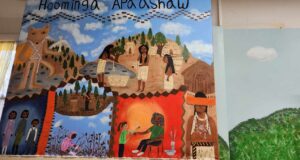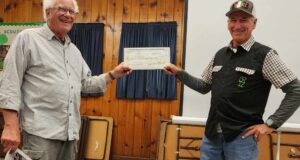Now available is a delightful new book highlighting the history of Willow Creek, the water that flows from high in the Sierra Nevada Mountains into Bass Lake.
The author, Marcia Penner Freedman, has taken the reader on the journey down the mountains into the lake and enlightened us with the power produced beyond this recreational wonder.
Included are side insights into cow camps, shake makers and basket weavers. From the “Introduction,” (p 14) the following:
Willow Creek is a strip of water that begins its journey high in the Sierra National Forest and ends—after a descent of seven thousand feet—at its confluence with the San Joaquin River, twenty-five miles downstream.
For the past one hundred and fifty years, Willow Creek has been at the center of economic and cultural development in the foothills of the Sierra. Native tribes that inhabited the areas around Willow Creek for hundreds of years continue to reside in the vicinity of the creek.
The Sierra National Forest had its beginnings around Willow Creek. For generations, ranchers have passed their herds by Willow Creek in their summer treks to the high country. In the 1850s, Willow Creek’s waters became a coveted source of money and power for settlers and industrialists. Since that time Willow Creek has been diverted, siphoned and dammed in the service of the logging and hydroelectric industries.
In the first fifteen miles of its run to the San Joaquin, Willow Creek crashes through narrow granite canyons and meanders through serene mountain forests. One can find ditches and siphons, long ago grown over, that carried Willow Creek waters to three flumes that were among the longest and most innovative in the world.
Its waters contributed to the conveyance of the rough-cut lumber down sixty miles of flume to a large mill that became the city of Madera in 1876. Logging railroads passed over Willow Creek and ran beside it. Only railroad grade roads exist now, reminders of that time.
The four campgrounds along the Willow Creek path were at the center of the logging industry. Today these campgrounds provide opportunities for outdoor adventurers to explore and experience the wilderness and for people to escape the summer heat of the valley, swim in Willow Creek’s pools or simply enjoy the serenity and peace of the forest.
At the end of the first leg of its journey, Willow Creek pours into Bass Lake, and it is there that it is transformed into the hard-working water of the PG&E hydroelectric system. Before joining the San Joaquin River, the waters of Willow Creek will pass through five power stations that generate twenty-seven megawatts of power for the state of California, provide recreation for visitors and local residents in a system of three lakes and contribute to the irrigation of the Central San Joaquin Valley, the richest agricultural area in the state.
Willow Creek History is available from bookstores and from the Coarsegold Historic Museum.



